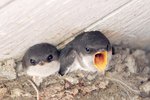Things You'll Need
Cardboard box
Proper food
Towels
Safe, dark area
Heating pad
Cereal bowl
Thermometer
Plastic syringe
Raising a wild baby bird on your own is not recommended by animal care professionals. If you must though, it is key to have a secure home for the baby bird, food, and proper health care and handling. Raising a baby bird requires a lot of time, materials and dedication, and just because you do this does not necessarily mean that the bird will tame and not fly away in the future.
Create a home for the baby bird in a cardboard box that has enough room for the bird to move around in. Ideal measurements would be about 1 foot long by 1.5 feet wide, and about 1 foot deep. Place a low-setting heat pad on the floor of the cardboard box. Make sure to not use something like an aquarium, as this provides poor circulation.
Put a cereal bowl in the middle of this heating pad. This will provide the baby bird with its own nest area. Make sure it is high enough a bowl that the baby bird won't fall out of, because direct contact with the heating pad could injure it. Layer the bottom of the bowl with a soft folded towel.
Do not use any bedding in the box such as hay or straw. This may make the bird ill. Place the baby bird into the bowl once the heating pad is on low, and the temperature you will want to keep at is 80 degrees. Place a thermometer against the towel to make sure it regulates.
Observe the baby bird to see if he exhibits any signs of illness. If the bird is keeping his mouth open or seems to be panting, he is too hot. If he is shivering, he is cold. If he seems restless or extremely confused, this may be signs of disease or illness.
Keep the baby bird's home in a dim place not directly under lights. Also, lay a towel over the top of the box with a corner open to provide air and some light. Clean the cage bedding every couple days to get rid of droppings.
Keep an eye on the growth, which should happen each day noticeably. You will be able to tell the bird is growing from foot and feather development, and color changes. Notice the baby bird's energy level as well. He should want to eat and stretch towards you when you bring your hands down.
Do not provide the baby bird with ANY water whatsoever, as this will make the bird sick. The bird receives enough hydration from the food it eats. Use a plastic syringe to feed the bird, and make sure all food given to the bird is warmed slightly.
Feed the baby bird only chopped up wingless fruit flies, meal worms, wax worms, and crickets. You must feed the baby bird every 15 to 20 minutes when you are awake. This schedule will only last about 2 weeks, and after that, you can decrease the consistency with which you feed the baby bird. After a while, you will be able to tell when the baby bird is hungry, since he will open his mouth and put his head back. Do not feed the bird any dairy or meat products that you eat, grains, fruits, earthworms and bugs such as ants or caterpillars.
Keep the bird box in a dark area during the night for the first week or two, to help the baby bird learn to sleep for eight hours a night. This will help it gain strength and get on a sleeping pattern.
Notice the rate that the baby bird's feathers are growing in. They should slowly start to grow in within a couple of weeks, and may have all of its feathers within a month.
Help the bird learn to fly. At about a month, the bird will officially be a fledgling. Take it out of the box often and hold it in your hand, slowly moving it up and down to help the bird get used to gravity and learn how to stretch out its wings.
Warnings
Do not let other animals near the baby bird.





